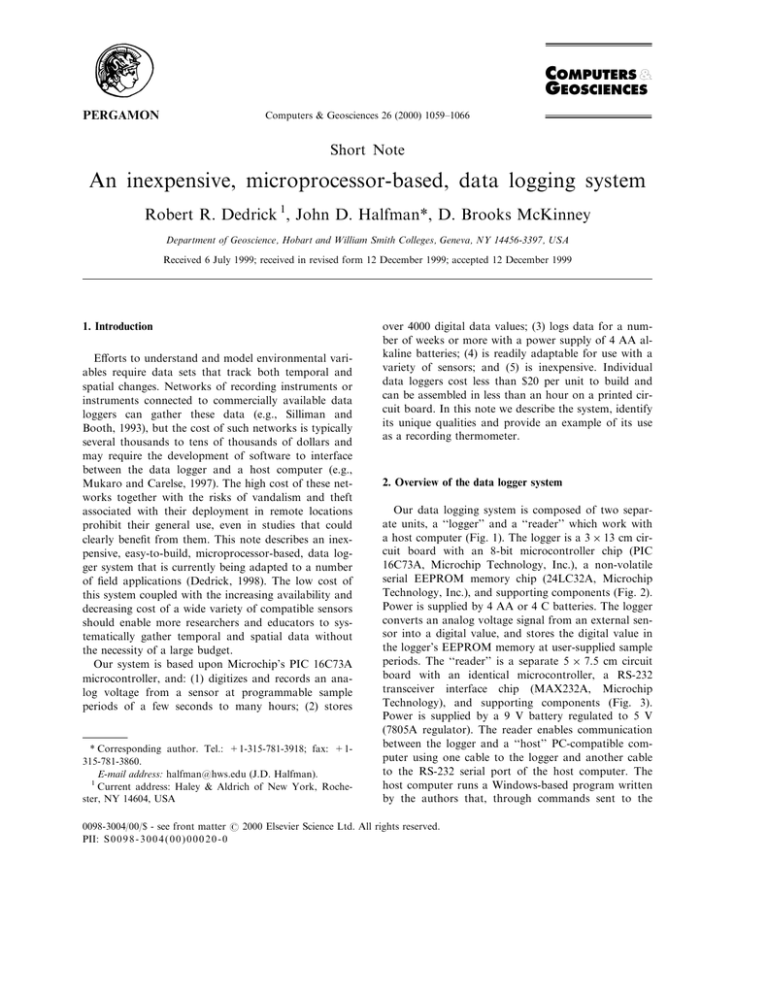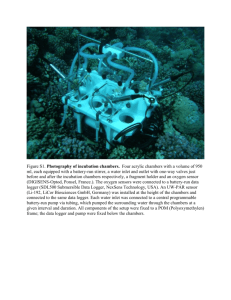
Computers & Geosciences 26 (2000) 1059±1066
Short Note
An inexpensive, microprocessor-based, data logging system
Robert R. Dedrick 1, John D. Halfman*, D. Brooks McKinney
Department of Geoscience, Hobart and William Smith Colleges, Geneva, NY 14456-3397, USA
Received 6 July 1999; received in revised form 12 December 1999; accepted 12 December 1999
1. Introduction
Eorts to understand and model environmental variables require data sets that track both temporal and
spatial changes. Networks of recording instruments or
instruments connected to commercially available data
loggers can gather these data (e.g., Silliman and
Booth, 1993), but the cost of such networks is typically
several thousands to tens of thousands of dollars and
may require the development of software to interface
between the data logger and a host computer (e.g.,
Mukaro and Carelse, 1997). The high cost of these networks together with the risks of vandalism and theft
associated with their deployment in remote locations
prohibit their general use, even in studies that could
clearly bene®t from them. This note describes an inexpensive, easy-to-build, microprocessor-based, data logger system that is currently being adapted to a number
of ®eld applications (Dedrick, 1998). The low cost of
this system coupled with the increasing availability and
decreasing cost of a wide variety of compatible sensors
should enable more researchers and educators to systematically gather temporal and spatial data without
the necessity of a large budget.
Our system is based upon Microchip's PIC 16C73A
microcontroller, and: (1) digitizes and records an analog voltage from a sensor at programmable sample
periods of a few seconds to many hours; (2) stores
* Corresponding author. Tel.: +1-315-781-3918; fax: +1315-781-3860.
E-mail address: halfman@hws.edu (J.D. Halfman).
1
Current address: Haley & Aldrich of New York, Rochester, NY 14604, USA
over 4000 digital data values; (3) logs data for a number of weeks or more with a power supply of 4 AA alkaline batteries; (4) is readily adaptable for use with a
variety of sensors; and (5) is inexpensive. Individual
data loggers cost less than $20 per unit to build and
can be assembled in less than an hour on a printed circuit board. In this note we describe the system, identify
its unique qualities and provide an example of its use
as a recording thermometer.
2. Overview of the data logger system
Our data logging system is composed of two separate units, a ``logger'' and a ``reader'' which work with
a host computer (Fig. 1). The logger is a 3 13 cm circuit board with an 8-bit microcontroller chip (PIC
16C73A, Microchip Technology, Inc.), a non-volatile
serial EEPROM memory chip (24LC32A, Microchip
Technology, Inc.), and supporting components (Fig. 2).
Power is supplied by 4 AA or 4 C batteries. The logger
converts an analog voltage signal from an external sensor into a digital value, and stores the digital value in
the logger's EEPROM memory at user-supplied sample
periods. The ``reader'' is a separate 5 7.5 cm circuit
board with an identical microcontroller, a RS-232
transceiver interface chip (MAX232A, Microchip
Technology), and supporting components (Fig. 3).
Power is supplied by a 9 V battery regulated to 5 V
(7805A regulator). The reader enables communication
between the logger and a ``host'' PC-compatible computer using one cable to the logger and another cable
to the RS-232 serial port of the host computer. The
host computer runs a Windows-based program written
by the authors that, through commands sent to the
0098-3004/00/$ - see front matter 7 2000 Elsevier Science Ltd. All rights reserved.
PII: S 0 0 9 8 - 3 0 0 4 ( 0 0 ) 0 0 0 2 0 - 0
1060
R.R. Dedrick et al. / Computers & Geosciences 26 (2000) 1059±1066
Fig. 1. Photograph of prototype logger and reader circuit boards without protective housing. Standard telephone wire and modular
plugs connects reader to logger and logger to sensor. Reader is connected to host computer through standard RS-232, 9-pin, female
connector. For scale, logger circuit board is 3 13 cm, and reader board is 5 7.5 cm. Tallest component extends approximately
2 cm above circuit board.
R.R. Dedrick et al. / Computers & Geosciences 26 (2000) 1059±1066
reader and relayed to the logger's memory chip, initializes the logger at the beginning of data collection and
retrieves data once sampling is completed. Typically, a
logger is connected to the reader for initialization, then
disconnected from the reader, connected to the sensor
and deployed in the ®eld for data collection, and
®nally reconnected to the reader to download and
store the data on the host computer.
Operation of the system depends upon coordinated
software running on the host computer, reader and
logger. The ¯ow chart in Fig. 4 shows how the software of the host, reader and logger function (vertical
columns), as well as how all three programs are linked
by software ``handshakes'' (links between columns).
Ultimately, digitized sensor data are saved on the host
computer as a character-delimited (``^ ''), ASCII text
®le. The sensor data in this ®le are uncalibrated numbers ranging between 0 and 255, re¯ecting the 8-bit
resolution of the microcontroller's on-board analog to
digital converter. This ®le also includes user-supplied
comments about the deployment (e.g., ®eld location),
sensor and logger information (e.g., serial numbers),
start time, start date, sample period, memory state,
and sample times. This text ®le is readily imported into
a spreadsheet for analysis. For example, most appli-
1061
cations will require that the ®le's digital sensor data be
converted to standardized units (temperature, stage
height, pressure, etc.) by application of a calibration
function. An example data ®le appears in Appendix A.
3. Features and advantages of the system
Several aspects of the system deserve special note,
particularly the use of the PIC 16C73A microcontroller, the use of the serial EEPROM chip for data storage, the separate reader and logger, the low cost of
the system, the software design of the data download
and initialization functions, and the adaptability of the
logger to many dierent sensor types.
The PIC 16C73A, 8-bit, microcontroller (Microchip
Technology, Inc) is well suited for an inexpensive data
logger. It has a built-in analog-to-digital converter,
hardware and software support for serial communication and EEPROM data storage, an internal programmable timer that can operate in the background
but produce time-out interrupts, and very low power
consumption. Our system uses two identical microcontrollers, one in the reader, another in the logger. The
reader's microcontroller operates at a clock speed of
Fig. 2. Schematic of logger. Communication to reader and sensor are through standard telephone wires, control of operations is by
microprocessor (PIC 16C73A Microchip Technology, Inc.), data storage uses 2-wire serial EEPROM (24LC32A Microchip Technology, Inc), and power (+6 V) is from 4 AA or 4 C batteries.
1062
R.R. Dedrick et al. / Computers & Geosciences 26 (2000) 1059±1066
4 MHz to support 2400-baud serial communication
with the host computer. By contrast, the logger's
microcontroller operates at a slower clock speed of
32.768 kHz to simplify its timing functions and reduce
its power consumption. We have measured the operating current of the logger to be less than 2 mA. Assuming a 4 AA alkaline battery pack and battery
capacities of 2140 mAh (Glover, 1997), this provides a
theoretical 44 day operating supply (currently, 15 days
is our maximum ®eld trial duration). Sample periods
are user selected during initialization, and implemented
by two internal, cascaded 8-bit counters that provide
sample periods of 8 s to any multiple of 8 s up to approximately 6 days (8 s 28 28). The PIC microcontroller costs less than $10, and is available from many
dierent suppliers.
The use of a separate reader and logger is not
necessary, but advantageous for several reasons.
Segregating host communications functions into the
reader: (1) reduces the number of components and
complexity of the logger thus reducing the cost of
each logger; (2) allows the logger to operate at the
lower, power-saving clock frequency discussed
above; (3) allows a single reader to service many
loggers, signi®cantly reducing the total cost in the
typical situation where a project requires multiple
measurement sites (many loggers). Excluding the
housing, parts for the logger cost under $20, and
for the reader cost under $35.
A serial EEPROM chip serves as the logger memory
(24LC32A, Microchip Technology, Inc.). It is a lowcost and low-power storage solution designed to interface with the PIC microcontroller. This 4 K EEPROM
has 4096 memory locations, each capable of storing an
8-bit integer, i.e., a digital value from 0 to 255. More
importantly, it provides non-volatile storage for the
data logger. Even if the power source for the logger is
removed for extended periods of time, the data
remains in the EEPROM and can be retrieved. This
chip requires only a ``2-wire'' interface with the microcontroller, a serial data line (SDA) and a serial clock
line (SCL), which greatly simpli®es the remaining circuitry and so the cost of the system. It also makes it
possible for the reader and the logger to access the
EEPROM independently so that when the logger is
attached to the reader, the reader is storing and
retrieving information directly to or from the logger's
EEPROM, rather than relaying the data through the
Fig. 3. Schematic of reader. Communication is through RS-232 communication port to host computer and standard telephone wire
to logger. Control of operations is by microprocessor (PIC 16C73A, Microchip Technology, Inc.), serial interface to host computer
by MAX232 chip (Microchip Technology, Inc.), and power is from 9 V transistor battery. Optional power on/o LED is attached
to outside of protective enclosure (neither item is shown).
R.R. Dedrick et al. / Computers & Geosciences 26 (2000) 1059±1066
logger microcontroller. This simpli®es the logger circuitry and the associated software.
Our software design combines data transfer and
initialization functions so that the host computer
always transfers data from the logger before initialization is permitted. This contrasts with the operation of
generic data loggers in which data transfer and initialization may be separated. The operation of a generic
data logger typically has three stages: (1) initializing
the logger with date and sampling information; (2)
deployment of the logger and an attached sensor; and
(3) retrieval of the logger and transfer of the data to
the host computer. In our system, combined download
and initialization functions reduce the risk of reinitializing a logger before the data from a previous deployment has been transferred. Thus the operation of our
system has two stages: (1) transfer of data; followed by
(2) the option to reinitialize the logger for a new
deployment.
Our system is adaptable to a wide and increasing
array of sensors. To date, we have tested it with temperature, pressure and light intensity sensors, and
details of the temperature application are described
below. Virtually any sensor that produces an analog
voltage signal from ground (Vss) to the positive supply
1063
(Vpp) can be connected to the logger. In our case, the
approximate range is from 0 to 6 V. The microcontroller's on-board analog-to-digital converter produces an
8-bit digital value equal to the ratio between the analog signal and a voltage reference (minimum reference
voltage is 3 V). Thus the system can provide a theoretical resolution of approximately 0.5% (1/256) of the
reference voltage. Experiments with three dierent loggers tested at 25 and 38C over periods of 2 or 3 days
indicate that the time-of-sample errors are less than
12 s per day.
To maximize sensor battery life, the microcontroller
also provides a sensor ``control line'' logic output. In
the temperature sensor design described below, this
output is connected to a solid state relay (Aromot
AVQ 210E) that toggles power on and o to the sensor. When the control line output is high (+Vss),
power is connected to the sensor so it can warm up,
stabilize, and then provide output to the logger microcontroller; when the control line is low (ground),
power is disconnected from the sensor. Between
samples, all PIC microcontroller connections to the
logger are high-impedance inputs that are unaected
by voltage changes in the sensor circuit. An optional
sensor LED illuminates when the control line is on.
Fig. 4. Software and operation ¯ow chart for data logger system. Host sequence is in left column, reader sequence is in middle column, and logger sequence is in right column. Reader and logger software are power activated, i.e., each program starts when
power is applied to microcontroller, and stops when power is disconnected from microcontroller.
1064
R.R. Dedrick et al. / Computers & Geosciences 26 (2000) 1059±1066
The very low-cost of individual loggers allow our
system to be adapted to situations that might require
multiple input channels or data capacities of more
than 4000 samples (4 K) per deployment. Where multiple channels are required, one simply uses more loggers. At less than $20 per logger, this is a cost-eective
solution. When more than 4000 samples are required
during a deployment, one simply uses two or more loggers. This involves using multiple loggers with the
same sample period but staggered start times to independently sample and record sensor output. Each logger records data from its own sensor for the full
deployment period; the time-staggered data from each
logger are then standardized (based on individual logger/sensor calibration curves), combined and sorted by
time within any spreadsheet to produce a single data
set with the desired temporal resolution. Again the low
cost of individual loggers makes this option cost eective. An additional bene®t of multiple loggers is full
data coverage over the deployment period even if one
logger or sensor malfunctions (though at an increased
sample interval).
Though our system has many advantages, its eective use requires additional care and work on the part
of the user. First, although the system will work with a
wide-array of sensors, users must pay careful attention
to the output of these sensors. The microcontroller's
on-board analog-to-digital converter produces a number between 0 and 255 that is proportional to the ratio
of the analog sensor voltage to a voltage reference.
However, the minimum voltage reference is 3.0 V and
the maximum is approximately 6 V. Sensors that produce voltages outside this range, or sensors that only
produce a narrow range of voltages like pH and conductivity electrodes within this range (for example,
4.0±4.1 V) must be ``conditioned'' for use with the system. Coupling this type of sensor to the logger would
require an ampli®er circuit to boost the output of the
sensor into the 0±5 V range. Furthermore, the user
must establish a calibration between the analog-to-digital converter's digital values and the desired reference
units (degree Celsius, pound per square inch, etc.). The
calibration directly aects the accuracy and resolution
of the ®nal data. The user must also be concerned with
changes in calibrations over the range in environmental
conditions (temperature, pressure, humidity, etc.) that
the sensor/logger may experience. Finally, users must
be cautious about measuring rapidly ¯uctuating signals. The microcontroller's analog-to-digital converter
takes an ``instantaneous'' sample of sensor output presumed to constant over a period of at least several
milliseconds. Rapidly ¯uctuating signals may require
an ``averaging'' or ``peak hold'' circuit to make reliable
measurements appropriate to a particular investigation.
Discussion of signal conditioning circuits appropriate
to particular sensors and applications is beyond the
scope of this short note. An accessible introduction to
sensor, analog-to-digital conversion and signal conditioning is Carr (1997).
Fig. 5. Schematic for any ``variable-resistance/variable-voltage'' sensor. This example integrates thermistor to electronically measure
temperature. Communication is through telephone wire to logger. Power is from separate 9 V battery, regulated to 5 V. Exact
value for ®xed resistor (RF) depends on range of variable resistor (RT). Sensor's power toggles on and o by solid state relay connected to a ``control line'' from the logger's microprocessor to save battery life. Control line is turned on (+Vss) before sample
time to provide power to sensor circuit. This allows sensor to warm up, stabilize and then provide output to logger. It is turned o
(ground) after digitizing and storing sensor output. Optional LED illuminates whenever control line is on.
R.R. Dedrick et al. / Computers & Geosciences 26 (2000) 1059±1066
1065
solution to the collection of temporal and spatial ®eld
data for numerous research and educational endeavors.
It can be integrated with a large array of available sensors. The schematics, circuit board layouts, parts list,
suppliers, PIC and host software, and other associated
items will be published on a Web site so that any educator or researcher can download sucient information to construct her/his own data logger. In
addition to the recording thermometer example
described here, this Web site will also contain information on use of the logger as a pressure-based recording stream gauge. We welcome any and all
suggestions.
Fig. 6. Temperature data interpolated from logger output
using linear calibration curve over 5-day period. Sensor was
deployed between window and storm window of lab. Data
reveal signi®cant variation over daily and longer-term scales
that mimic observed daily and longer-term air temperatures
during sensor deployment. Signal is also in¯uenced by heating
cycle of lab and direct solar gain through window.
4. Recording thermometer application
Fig. 5 shows a schematic for a temperature sensor
that can be connected to the data logger system to create a recording thermometer. In this example, the sensing element is a thermistor used in series with a ®xed
resistor to create a voltage divider. The resultant voltage output varies with temperature, and Fig. 6 shows
the calibrated output of our test run. The sensor circuit
is powered by a separate 9 V battery regulated by a
7805A voltage regulator to provide a constant 5 V
power supply. A regulated supply eliminates voltage
drift that could result from decreasing battery output
over the deployment period. Pin one of the solid state
relay is connected to the sensor's ``control line.'' This
con®guration switches current ¯ow on and o through
the sensing circuit. The sensor and circuitry as shown
cost under $10 to construct.
The sensor was deployed between the inner and
storm window of our lab for approximately 5 days in
the fall to monitor daily cycles in air temperature
(Fig. 6). The daily cycle in temperature detected by the
data logger is temporally consistent with observed
daily and longer-term changes in outside air temperature over the deployment period. The plot also reveals
higher resolution ¯uctuations that are probably related
to the heating cycle of the room and periods of more
direct sunlight through the window.
5. Conclusions
The data logger system is an inexpensive and simple
Acknowledgements
John Vaughn and Larry Campbell, Hobart and William Smith Colleges, provided many useful suggestions
during the design and development of this data logger
system. Initial ®nancial support was provided by the
Committee on Research and Honors, Hobart and William Smith Colleges. The project is currently supported
by the National Science Foundation, Division of Education, CCLI-EMD 9950544. Hobart and William
Smith Colleges reserve the rights to this Data Logger
System, and allows at no charge educational and
research use of the data logger system. We are grateful
for the thoughtful reviews by Kevin Telmer and Quetin
Bristow on an earlier draft of the manuscript.
Appendix. Example data ®le
This data ®le reveals user-supplied comments, initialization variables, and the ®rst 52 digital values that
were subsequently converted to temperature using a
linear calibration curve and plotted in Fig. 6. The
remaining logger data are omitted for brevity.
User Supplied Comments:
Temperature Sensor in Lansing Hall Window
Start a few days ago
End 17:36 10/20/98
Start from logger data 20:55 10/14/98
Hope to see daily temperature cycle
Initialization Parameters:
EEPROM
Address
0
1
2
3
Value
1
1
1
0
Description
Logger Serial Number
Type of Sensor
Sensor Serial Number
Not used Ð proposed counter
for start delay
1066
R.R. Dedrick et al. / Computers & Geosciences 26 (2000) 1059±1066
4
0
5
1
6
55
7
8
9
10
11
12
20
14
10
98
19
15
13
2
14
8
15
255
Number of
Data=2033
Not used Ð proposed counter
for start delay
Data Read Yet? (no=0,
yes=1)
Start Minutes Ð Seconds
Ignored
Start Hours
Start Day
Start Month
Start Year
Start Century
Number of 8 s. Ticks per
Interval
Number of Intervals per
Sample
Last EEPROM Bank
Last Address in Last Bank
Logger Data:
EEPROM
Address
16
17
18
19
20
21
22
23
24
25
26
27
28
29
30
31
32
33
34
35
36
37
38
39
40
Date
(m,d,y)
10/14/98
10/14/98
10/14/98
10/14/98
10/14/98
10/14/98
10/14/98
10/14/98
10/14/98
10/14/98
10/14/98
10/14/98
10/14/98
10/14/98
10/14/98
10/14/98
10/14/98
10/14/98
10/14/98
10/14/98
10/14/98
10/14/98
10/14/98
10/14/98
10/14/98
Time
(h,m,s)
20:59:00
21:03:00
21:07:00
21:11:00
21:15:00
21:19:00
21:23:00
21:27:00
21:31:00
21:35:00
21:39:00
21:43:00
21:47:00
21:51:00
21:55:00
21:59:00
22:03:00
22:07:00
22:11:00
22:15:00
22:19:00
22:23:00
22:27:00
22:31:00
22:35:00
Logger
Data
52
49
48
47
47
47
47
46
46
46
46
46
46
45
45
45
45
45
45
45
45
45
45
45
45
41
10/14/98
42
10/14/98
43
10/14/98
44
10/14/98
45
10/14/98
46
10/14/98
47
10/14/98
48
10/14/98
49
10/14/98
50
10/14/98
51
10/14/98
52
10/14/98
53
10/14/98
54
10/14/98
55
10/14/98
56
10/14/98
57
10/14/98
58
10/14/98
59
10/14/98
60
10/14/98
61
10/14/98
62
10/15/98
63
10/15/98
64
10/15/98
65
10/15/98
66
10/15/98
67
10/15/98
. . . and continues at 4 min
2048
10/20/98
22:39:00
22:43:00
22:47:00
22:51:00
22:55:00
22:59:00
23:03:00
23:07:00
23:11:00
23:15:00
23:19:00
23:23:00
23:27:00
23:31:00
23:35:00
23:39:00
23:43:00
23:47:00
23:51:00
23:55:00
23:59:00
0:03:00
0:07:00
0:11:00
0:15:00
0:19:00
0:23:00
intervals up
12:23:00
45
45
45
45
45
44
44
44
44
44
44
44
44
44
44
44
44
44
44
44
44
44
44
44
44
44
44
to . . .
49
References
Carr, J.J., 1997. Electronic Circuit Guidebook: Sensors,
vol. 1, H. W. Sams Co, Indianapolis, Indiana, 339 pp.
Dedrick, R.R., 1998. Development of an inexpensive data logging system with an application to periodically measure
stream stage. Undergraduate Honors Thesis, Hobart and
William Smith Colleges, Geneva, New York, 105 pp.
Glover, T.J., 1997. Pocket Reference. Sequoia Publishing,
Littleton, 139 pp.
Mukaro, R., Carelse, X.F., 1997. A serial communication
program for accessing a microcontroller-based dataacquisition system. Computers & Geosciences 23 (9),
1027±1032.
Silliman, S., Booth, D., 1993. Analysis of time-series measurements of sediment temperature for identi®cation of gaining
and losing portions of Juday Creek, Indiana. Journal of
Hydrology 146 (1), 131±148.



